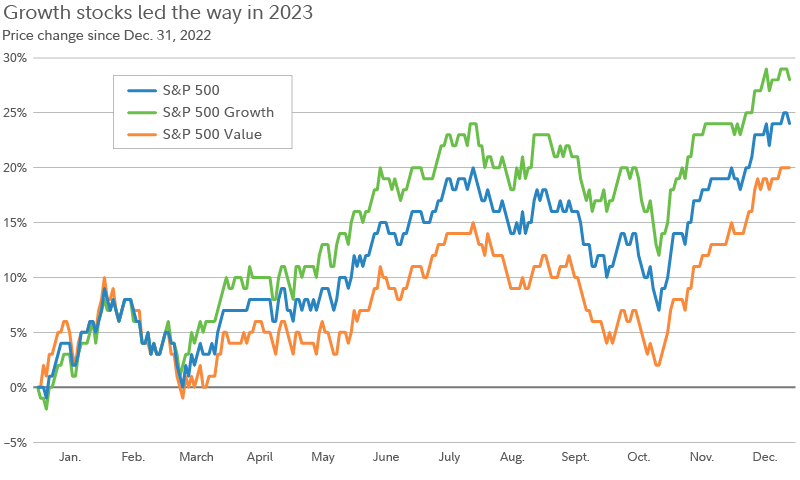Large-cap growth stocks staged a formidable comeback in 2023, defying a pessimistic outlook at the start of last year. The surprise rally, largely driven by big tech, helped the S&P 500 overcome the headwinds of higher interest rates and fears of a possible recession.
Now at the start of 2024, a key question is: Can this momentum for mega-cap growth persist, and which themes will take center stage?
While market leadership is always hard to predict, Fidelity’s large-cap focused managers say they are optimistic about market conditions for growth stocks and have found compelling opportunities in segments including artificial intelligence and weight-loss drugs.
Anatomy of growth vs. value stocks
The surprise performance of growth stocks last year belied the traditional thinking for such equities. In simple terms, rising interest rates are seen as unfavorable for growth stocks because their valuations often depend on present estimates of future earnings potential. Plus, higher borrowing costs can potentially hobble the growth initiatives needed to spur profitability.
Conversely, value stocks are thought to be less sensitive to interest rates, a potentially safer bet during times of market volatility. These are typically shares in more established, dividend-paying companies—in sectors like financials, industrials, or energy—which investors see as potentially undervalued. Certain fundamentals, like low P/E ratios and stable earnings growth, are among their attributes.
With intensifying fears that the Fed’s battle to cool inflation could tip the US economy into a recession, the outlook for growth stocks at the start of 2023 seemed grim. Market conditions appeared ripe for a possible rotation into value stocks. And yet as the year progressed, that narrative never materialized. The S&P 500 Growth Index outpaced the S&P 500 Value Index in 2023—a result largely powered by the titans of tech.

Will big tech’s rally endure?
The large gains seen in a group of mega-cap tech stocks in 2023 earned them the nickname “the Magnificent 7.” Those stocks—including Amazon (
Viewed over a 2-to-3-year horizon, Simnegar says he’s focused on “quality growth”—or what he sees as companies with relatively low P/E multiple risks that can compound at or above the market’s pace. Given the rise of AI over the past year, Simnegar says he’s optimistic about the potential for semiconductor makers. Some of these companies are involved in creating the chips that fuel the computational capabilities required to develop innovative AI applications and products.
“One of the hard things about investing is identifying trends and making sure the market is not overestimating them,” Simnegar says. “But I think the future is in machine learning and AI.”
Fund Top Holdings3
Top-10 holdings of the Fidelity® Magellan® Fund as of January 31, 2024:
- 8.4% - Microsoft Corp. (
) - 5.0% - NVIDIA Corp. (
) - 4.5% - Amazon.com Inc (
) - 3.5% - Meta Platforms Inc. Class A (
) - 3.2% - Alphabet Inc. Class A (
) - 2.4% - Broadcom Inc. (
) - 2.3% - UnitedHealth Group Inc. (
) - 2.3% - Visa Inc. Class A (
) - 2.3% - Eli Lilly & Co. (
) - 2.1% - Mastercard Inc. Class A (
)
(See the most recent fund information)
While AI enthusiasm has helped propel chip stocks over the past year, it’s important to note that industry dynamics can always change, especially over the long term. Yet as AI continues to advance, demand for semiconductors should potentially increase.
Some examples in the semiconductor space include Nvidia (
Separately, another ingredient needed to support the AI-chip boom is the hardware and equipment used to mass produce semiconductors. ASML Holding NV (
Obesity drugs
Along with AI, another theme that has gained prominence over the past year is the rise of drugs that combat obesity. Simnegar says there are “good indications these could be the biggest drugs of all time.”
Known as GLP-1 drugs, these medications—originally created to treat diabetes—target receptors in the brain, suppressing appetites and reducing food intake. The hype over these drugs and their potential long-term impact has alerted many other sectors, including health insurance and food companies. For instance, in October of last year, the CEO of Walmart said the retailer has already seen an impact on food-shopping demand from people taking the medications.
While it’s still early days, sales of anti-obesity drugs are projected by Bloomberg Intelligence to leap to $44 billion by 2030 from $2.5 billion in 2023, with around 70% in the US. Drug makers are now racing to bring weight-loss medications to market. As of 2023, there were more than 50 drugs in clinical development at around 40 companies, according to Bloomberg Intelligence.
Currently 3 GLP-1 drugs have been approved in the US to specifically treat weight loss. They include Wegovy and Saxenda, which are made by Novo Nordisk (
Does “athleisure” have room to run?
Optimism over the health and wellness trend is also shared by Sonu Kalra, who manages the Fidelity® Blue Chip Growth Fund (
Another theme where Kalra sees favorable tailwinds is “athleisure”— a segment of clothing that people wear not just for sports but also for comfort and everyday attire. “Not only are we trying to exercise more and eat healthier, but we're also dressing more casually on a daily basis,” Kalra says.
Starting with yoga pants, “athleisure” has expanded over the past decade to include sneakers, hoodies, sweatpants, and many other accessories. The increasing popularity of this aesthetic is said to have led to a significant shift in the way many Americans dress. Global “athleisure” sales are projected to reach $3.2 billion by 2032, up from $2 billion in 2022, according to Allied Market Research.
One of the most prominent brands in the “athleisure” industry is Lululemon (
Fund Top Holdings3
Top-10 holdings of the Fidelity® Blue Chip Growth Fund as of January 31, 2024:
- 11.4% - NVIDIA Corp. (
) - 9.8% - Microsoft Corp. (
) - 8.4% - Amazon.com Inc (
) - 8.3% - Apple (
) - 6.1% - Alphabet Inc. Class A (
) - 5.0% - Meta Platforms Inc. Class A (
) - 3.5% - Marvell Technologies Inc. (
) - 2.4% - Eli Lilly & Co. (
) - 2.3% - Snap Inc. (
) - 2.3% - Netflix Inc. (
)
(See the most recent fund information)
Streaming wars
Over the last decade a lot of ink has been spilled documenting the shift from traditional cable TV subscriptions to internet streaming services. Yet despite this change in viewing habits—cable TV accounted for 29.6% of viewing compared with 38.7% for streaming in 2023 according to Nielsen—advertising spending has been slower to flow to streaming. So says Kyle Weaver, co-manager of the Fidelity Advisor® Series Growth Opportunities Fund (
Weaver has been more focused on the connected TV devices that allow viewers to stream shows and movies. And given that the increasing number of streaming services has sparked debate over whether there’s an oversaturation of content, Weaver emphasizes the importance of these platforms. They generate revenue from hardware sales, licensing, and advertising on their home screens.
“As long as people are streaming overall, and there’s competition among some number of streamers, that space on the front of the screen every time you turn your TV on is very valuable to anyone who wants you to watch their show over somebody else’s.”
As of Q3 2023, Roku Inc. (
Fund Top Holdings3
Top-10 holdings of the Fidelity Advisor® Series Growth Opportunities Fund as of January 31, 2024:
- 11.1% - Microsoft Corp. (
) - 8.4% - NVIDIA Corp. (
) - 5.9% - Meta Platforms Inc. Class A (
) - 5.3% - Amazon.com Inc (
) - 5.3% - Alphabet Inc. Class C (
) - 3.1% - Uber Technologies Inc. (
) - 2.6% - Roku Inc. Class A (
) - 2.5% - T-Mobile US Inc. (
) - 2.1% - Alphabet Inc. Class A (
) - 1.8% - Apple Inc. (
)
(See the most recent fund information)
Macro themes
Several macroeconomic themes could have an impact on financial markets in 2024 and beyond. Fidelity fund managers say they’re keeping a close eye on whether the Fed can navigate a soft landing for the economy, the health of US consumer spending, and signs of a resurgence in China’s economy.



